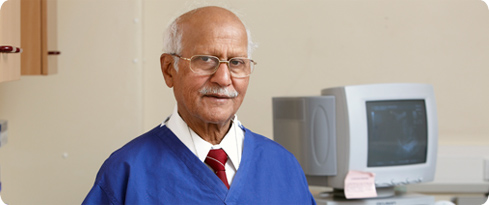Your views

Your feedback is vital to us as we continue to increase the quality of our services.
You are here:
Date: 20 December 2024
Time: 14:44

UHB histories: interview with Nalin Chokshi
Before the move to the new Queen Elizabeth Hospital Birmingham (QEHB) began, Joe Stein from the Communications Team spoke to Consultant Radiologist Dr Nalin Chokshi about the changes he has witnessed over the years.
Dr Chokshi began working in Birmingham in 1976 at the old Queen Elizabeth Hospital (QEH). He moved to Selly Oak Hospital (SOH) soon afterwards and has worked there ever since.
When Dr Chokshi first came to Selly Oak Hospital, the Imaging Department and its working practices were vastly different from today.
Then, imaging services were split into four areas across the site. There were no imaging facilities for inpatients so they had to be taken across the site to the Outpatient Department for assessment. CT scanning could not be provided at all. Every Monday afternoon, staff took patients over to QEH, or even as far as West Bromwich, to get their scans.
”Out of the darkness and into the light”
The biggest changes Dr Chokshi has seen have been caused by technological advances which have opened up myriad ways of viewing the insides of the human body.
He says: “One of the major differences was that, in those days, everything was done by hand. X-rays had to be washed, rolled, and dried – it was a long process.
“In the 1970s, ultrasound, nuclear imaging, angiograms and CT scanners were still being developed. The idea of MRI had hardly even been conceived.
“All X-ray departments used to be based in cellars because it was only in complete darkness that the old facilities could work. We used to have to wear red goggles for thirty minutes before we went into the darkroom so our eyes could adjust to the darkness.
“There was always a particular smell to the Radiology Department because of the chemicals we used – it was damp and sulphurous. This all contributed to the old image of the radiologist.
“The most significant advances in X-ray were machines that combined and automated the whole development process – they would process the image in one go. Because the film could now be placed in cassettes, we no longer required darkness to work. We literally walked out of the darkness and into the light.
“In 1977, we got our first ultrasound machine here at Selly Oak. Building rooms for MRI and CT scanners was always difficult because special measures were needed to contain radiation and magnetic fields. But they were installed and it all contributed to the new ways we now have of looking inside the body.
“Of course, these technologies continued to be improved and expanded enormously over the coming decades. But the next really significant change to our day-to-day work was in 2005. Until that time, we were the kings – we had the only image – we owned it. Now with digital radiology, as soon as you take the picture, there are thousands of other copies.”
The new character of medicine
Dr Chokshi has also seen many changes in the character of the hospital. In his time, old hierarchies have been broken down and replaced with a new working ethos: “When I started working in medicine, it was almost like a family structure. The consultant was the father and the patient his children. Nurses, technicians and support staff provided vital support.
“Nowadays, the patient is on top and gets services from the ‘team’. To bring about any change at all they had to completely destroy the old ethos and hierarchy. If you want to make an omelette you have to break the eggs.”
With the move into the new hospital edging ever closer, Dr Chokshi was thoughtful as to how the two institutions will work as one.
“There are aspects of both Selly Oak and Queen Elizabeth hospitals that are very different but there are many more which are the same.
“It will certainly be interesting to see how the two cultures merge together in the new hospital. I would like to think that the best elements of each will shine through.”
Related pages

Getting here
Information about travelling to, staying at and getting around the hospital.

Jobs at UHB
A great place to work. Learn why.


